News From the Festival
Steel Magnolias First Look

Steel Magnolias previewed on June 21, officially opened on June 28, and runs through October 4 at the Randall L. Jones Theatre. Members of our artistic teams had about seven weeks to prepare this show for audiences, designing the wigs (so many wigs!), makeup, and costumes that transform each performer seen here in these studio photos.
Steel Magnolias costume design by Lauren Roark. Wigmaster Dana Rochester. Assistant wigmaster Brittany McDowell. All photos by Karl Hugh.
See the rest of their work on our Randall L. Jones stage this season. Tickets available at bard.org or by calling 800-PLAYTIX.






Steel Magnolias: Exploring Humor and Self-Expression to Cope with Difficulties
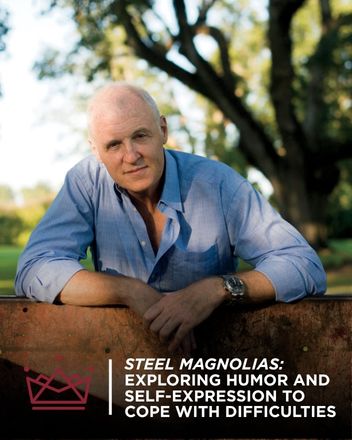
By Liz Armstrong, guest writer
Theatre has long been a form of expression that captures the essence of the human experience. Since possibly as early as 2500 BCE, it has been a way to help both performers and audiences cope with the challenges and difficulties of life.
But the creation and writing of a play itself can be just as therapeutic. This is especially true for playwright Robert Harling with his play, Steel Magnolias. For him, writing the play served as a cathartic process while he struggled to cope with the passing of a loved one.
In 1985, Harling’s sister Susan Harling-Robinson passed away from diabetic complications after the birth of her son, and the transplant failure of a family-donated kidney.
Harling’s friend encouraged him to write to help him come to terms with the death of his sister. The playwright not only did this to help process his own grief, but hoped it would give his nephew an understanding of his deceased mother.
“I desperately needed to celebrate [my sister], my mother, and the loving community of neighborhood ladies that had supported them through good times and bad,” Harling wrote for Garden and Gun.
He was an actor at the time, and what originally was going to be a short story developed into a play, where Harling explored themes of coping. Through the play, he illustrates the various ways in which the characters deal with the hardships they encounter.
Set in a hair salon, the women of Steel Magnolias share their lives and laughter with each other.
“I don’t trust anybody that does their own hair. I don’t think it’s normal,” Truvy, a character in Steel Magnolias, says.
This humor was based on Harling’s own sister.
“She had an ability to turn a phrase that could make you laugh and cry at the same time,” Harling said.
The characters in Steel Magnolias lean on humor throughout the play as a coping mechanism, representing what Harling’s own family did before and after Susan’s death.
“Laughter through tears is my favorite emotion,” Truvy says*.* According to Harling, it seems that was Susan’s favorite emotion too.
Written in just ten days, the play not only served to honor Harling’s sister, but lives on as a symbol of resilience for all those who experience the story. It portrays the indomitable tool of using humor, love, and friendship to find the strength to move forward, especially when doing so seems impossible.
The play has shown its own form of resilience, with people still quoting, performing, and enjoying it nearly 40 years later.
One of Harling’s most famous quotes from Steel Magnolias is: “I’d rather have 30 minutes of wonderful, than a lifetime of nothing special.”
Originally opening off-Broadway, the national tour launched in 1989 and hit the West End in London the same year.
In 2005, Steel Magnolias made its Broadway debut. It was also adapted for the well-known film of the same name, starring Julia Roberts, who was nominated for the Academy Award for Best Supporting Actress as the character Shelby. Steel Magnolias was adapted again as a film in 2012.
Since its debut, Harling said that he knows of seventeen authorized translations of the play, having seen it performed in Japanese, Chinese, French, Swedish, Spanish, and Italian, demonstrating its ability to transcend languages and cultures.
One thing Harling has learned throughout the popularity of his work: beauty parlors are universal. But even more universal, though, is the theme of the strength of female friendships and humor despite all odds.
To see this touching play, visit bard.org to purchase tickets. Steel Magnolias opened June 28 and runs through October 4 in the Randall L. Jones Theatre.
Utah Shakespeare Festival Opens 64th Season
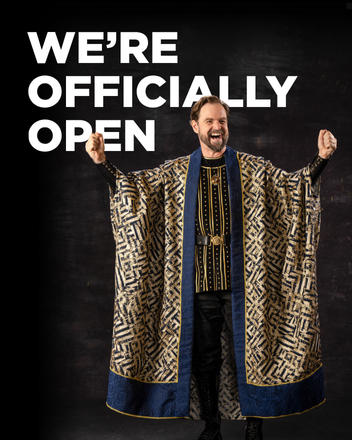
The Utah Shakespeare Festival is excited to announce the opening of its 64th season. After months of preparations and six weeks of an intensive build process and rehearsal schedule, the Festival welcomes patrons to experience another wonderful season of live theatre, now through October 4.
The Utah Shakespeare Festival is a professional theatre, hosted on the campus of Southern Utah University and was started in 1961 by the late Fred C. Adams and his wife Barbara.
“Fred will always be remembered as a passionate visionary who saw Cedar City and the university (College of Southern Utah at the time) as an ideal home for a world-class theatre,” says Executive Managing Director Michael Bahr. “Because of the town’s history with putting on plays, its connection to the works of William Shakespeare, and its location near some of the most beautiful recreation destinations in the country, Fred knew the Festival could be a thrilling addition to the campus and community.”
Today, with a year-round administrative staff of 30, a seasonal staff of over 200 theatre professionals, and a volunteer base of 350 local residents, the Festival welcomes over 100,000 guests to the annual productions each year.
From Shakespearean masterpieces to laugh-out-loud comedies and modern favorites, this season offers something for everyone. The lineup includes William Shakespeare’s dark and tragic Macbeth, the historical romance (and rarely-performed) Antony and Cleopatra, and the pastoral comedy As You Like It in the outdoor Engelstad Shakespeare Theatre.
In the beautiful indoor Randall L. Jones Theatre, audiences won’t want to miss the witty and touching Steel Magnolias by Robert Harling*,* the Tony Award-winning musical comedy A Gentleman’s Guide to Love and Murder by Steven Lutvak and Robert L. Freedman, and the Victorian satire The Importance of Being Earnest by Oscar Wilde.
In the intimate Anes Studio Theatre, patrons can enjoy the World War II love story Ken Ludwig’s Dear Jack, Dear Louise, a week-long traveling production of Twelfth Night by the students of London’s Royal Academy of Dramatic Art (RADA) at the end of July, and two new plays––one of which is Lauren M. Gunderson’s Muse of Fire––for the annual Words Cubed staged reading new play program during August.
“All of these productions represent the very best––and sometimes the most challenging––parts of all of us,” comments Artistic Director John DiAntonio who oversees each show from hiring the directors and casting to ensuring finishing touches are complete before the curtains rise and audiences show up. “We are thrilled to celebrate these stories and these artists, and welcome everyone to experience the power of live theatre.”
In addition to the plays, other opportunities referred to as the Festival Experience ensure that audiences’ participation goes beyond––and sometimes behind––the stage. A variety of seminars, pre-show orientations, Backstage Tours, Repertory Magic, classes, camps, and more aim to enhance patrons’ understanding of Festival productions and the process of repertory theatre. And no evening at the Festival would be complete without attending The Greenshow. Bring the whole family for this free 30-minute celebration starting at 7:10pm, Monday through Saturday, where everyone is invited to sing, dance, and play along.
Tickets are on sale now! Visit bard.org, call 800-PLAYTIX, or visit the Ticket Office for more information and to reserve your seats.
Making a Scene: 50 Shows with Jo Winiarski

By Kathryn Neves, guest writer
A hair salon, pink and blue and perfectly ‘80s. A pristine parlor of portraits, shaped like a Victorian picture frame. And a worn-through stage with faded red curtains—setting the stage for mischief, mayhem, and murder. This is just a glimpse of the amazing work Scenic Designer Jo Winiarski has put into the three shows in the Randall L. Jones Theatre this season. This year Winiarski celebrates an incredible milestone—her fiftieth production at the Utah Shakespeare Festival!
For Winiarski, scenic design is all about collaboration. She has fond memories of past productions, working with the directors and other designers to create something theatrical and beautiful. After over twenty years at the Festival, it’s the friendships and the teamwork that she values most.
“Working with Ben Hohman and Richard Girtain on the production team for so long creates a way of working that can only be gained after many years,” she said. Some of her favorite past collaborations include Les Misérables and an afternoon taping together a rough model, designing The Complete Works of William Shakespeare (Abridged) as a love letter to the Festival, and her beautiful work on last season’s The Mountaintop and Silent Sky.
One of the most rewarding aspects of Winiarski’s work involves fitting her productions efficiently into the Festival’s repertory rotation. “It’s an ever changing challenge,” she said. “How to fit three shows into the theater, and have each show tell its own visual story. I try to think about it like one large play with three very distinct acts.” While there is some scenic overlap between the productions, each one is self-contained; the designs all share the same theater, but transform it each night into distinct and vibrant emotional worlds.
“Good design first and foremost serves the play,” said Winiarski. “I think about how to shape and hold the world for these characters. What is the emotional shape of the space? I don’t think there is any rule for every show, except that the play comes first.” Her design philosophy, while putting the play’s text first and foremost, gives her space to explore, evolve, and experiment. “I now make bolder choices than I did earlier in my career,” she said, explaining that this has created a “stronger display of personal design style while still serving the play.”
After fifty productions at the Utah Shakespeare Festival, Winiarski has built an unrivaled legacy of design and theatricality. Other Festival productions she designed include Clue (2022); Ragtime (2021); The Pirates of Penzance (2021); Boeing, Boeing (2014); Peter and the Starcatcher (2013); To Kill a Mockingbird (2012); The Taming of the Shrew (2008); and The Fiddler on the Roof (2008).
“I feel very lucky to have been a part of the Festival for this long,” she said. “To have an artistic home is a gift that is not easy to come by.” For her, fifty productions “means knowing the theater well. It means always trying to find new ways to present the work to the audience.” From her first few years as an assistant designer, to her incredible body of work over the last twenty years, Winiarski is a Festival favorite. “I keep coming back because the Festival is my artistic home,” she said. Her work defines how audiences experience the Festival and its shows, year after year.
This season, come and see her incredible work in all three Randall shows. Steel Magnolias, The Importance of Being Earnest, and A Gentleman’s Guide to Love and Murder are full of comedy, heart, and spectacular visuals. With fifty productions behind her, Jo Winiarski’s work is something to celebrate—and to see for yourself.
The Greenshow First Look

The Greenshow officially opened on June 19, and runs through September 6 on the Ashton Family Greenshow Commons. Its artistic team had six weeks to prepare these performers, and build costumes, hair/makeup, and props seen here in the first set of photos.
The Greenshow costume design by Diana Girtain. Wigmaster Dana Rochester. Assistant wigmaster Brittany McDowell. Props by Benjamin Hohman and Marielle Boneau. All photos by Karl Hugh.
See the three themed evenings of The Greenshow––Highland Games, Mariner, and Mountain Wilderness–– this season, plus two special performances by the Paiute Indian Tribe of Utah on July 18 and August 2. Free for the whole family!








Meet the Playwright: 10 Fun Facts about Oscar Wilde
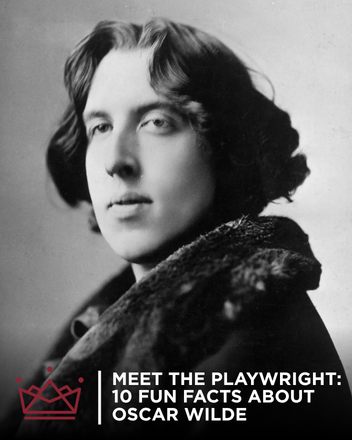
By Kathryn Neves, guest writer
This summer at the Utah Shakespeare Festival, we’re putting on one of the most entertaining plays in the English language. The Importance of Being Earnest has always been a Festival favorite; this’ll be our third production in our 64-year history! And, even before the start of the Festival, Founder Fred C. Adams played the imposing Lady Bracknell in a college production. Truly, this play is iconic.
But as iconic as the play is, it doesn’t hold a candle to its playwright. One of the most eccentric, witty, and prolific writers in the English language, Oscar Wilde’s life was as crazy as his name. Let’s take a look at a few fun facts about this season’s most “Wilde” playwright.
1. He was a leader of Aestheticism
A new artistic trend was on the rise in Victorian England—aestheticism. This movement prioritized beauty and form above all else. In art, in poetry, in fiction, only the aesthetics mattered. It didn’t matter if art “meant” something, or if it taught a lesson or made commentary. The top priority was the aesthetic quality of a work. This movement is where the phrase “art for art’s sake” comes from. Oscar Wilde was, and still is, one of the most famous “aesthetes” of all time.
2. He was a jack-of-all trades
In addition to being very prolific, Wilde wrote in a wide variety of genres and forms. While his plays and one novel are probably his most famous works, Wilde wrote dozens of poems, essays, short stories, speeches, arguments, dialogues, and political dissertations.
3. He was an Irish Nationalist
Wilde was born in Ireland—Oscar Fingal O’Flahertie Wills Wilde—to a very political family. His parents were active in the cause of Irish Nationalism, and as an adult, he picked up the cause too. Most of his politics were focused on Ireland’s right to independence and sovereignty.
4. He was (maybe?) a child prodigy
As an adult, Oscar Wilde made some bold claims about his childhood. He told schoolmates that he was born brilliant; one especially modest claim was that he could “speed read.” According to him, he could read two facing pages at the same time, and he could read a 3 volume book in under half an hour.
5. He was briefly a Freemason
During his Oxford years, Oscar Wilde was initiated into the Apollo Masonic Lodge. He participated heavily and even attained the title of Master Mason. However, after he left Oxford, he stopped all active involvement and stopped paying his membership dues.
6. He loved Shakespeare
Oscar Wilde was a brilliant student of classical literature—including the study of the Bard. That love of Shakespeare continued past his school years; in 1889 he wrote a story called “The Portrait of Mr. W. H.” The story followed the attempt to identify Mr. W. H.—the mysterious figure to whom Shakespeare dedicated his book of sonnets.
7. He was unjustly imprisoned
Victorian England had strict laws against homosexuality, resulting in the unfair imprisonment of gay men across the kingdom. In 1895 one of his male lovers came to light, and Wilde was put through a humiliating trial. He was sentenced to two years in prison—a grueling and cruel experience he wrote about in The Ballad of Reading Gaol. After his release, Wilde’s creative output was much slower, and he moved to France—never again to return to the U.K.
8. He had a pseudonym
After his prison stay, Oscar Wilde wanted to live in anonymity. To that end, he sometimes went by another name—Sebastian Melmoth. “Sebastian” came from the Catholic Saint Sebastian, and Melmoth came from the title character of Melmoth the Wanderer—a novel written by his great uncle, Charles Maturin.
9. He became a Catholic late in life
From the time he was very young, Wilde expressed a lot of interest in Catholicism. As a young man he was nearly baptized, before he abruptly changed his mind (and sent flowers to the priest as an apology). However, at the very end of his life, Wilde decided to go through with it. He was baptized into the Catholic church on November 29, 1900—and died the very next day.
10. The Importance of Being Earnest is considered a theatrical masterpiece
Oscar Wilde wrote nine plays during his life; and, though they were all excellent, none of them were as popular or iconic as The Importance of Being Earnest. The play’s success firmly cemented Wilde as one of the literary greats. Even now, more than 100 years later, people still flock to see the show—an honor reserved for only the best playwrights.
Come see The Importance of Being Earnest this season at the Festival! Full of unforgettable characters and the wittiest (and fastest) dialogue you’ll ever hear, it’s not a show you’ll want to miss.
For tickets or more information, visit bard.org.
The Importance of Being Earnest First Look

The Importance of Being Earnest previewed on June 20, officially opens June 27, and runs through October 4 at the Randall L. Jones Theatre. The artistic team for this delightful show have been busy preparing for audiences, designing the hair, makeup, and costumes that transform each performer seen here in this first look.
The Importance of Being Earnest costume design by Bill Black. Wigmaster Saylor Hartner. Assistant wigmaster Bria Hansen. All photos by Karl Hugh.
See the rest of their work on our Randall L. Jones stage this season. Tickets available at bard.org or by calling 800-PLAYTIX.






A Gentleman's Guide to Love and Murder First Look

A Gentleman’s Guide to Love and Murder previewed on June 19, officially opens June 26, and runs through October 3 at the Randall L. Jones Theatre. Members of our artistic teams have been busy preparing the musical for audiences, designing the hair, makeup, and costumes that transform each performer seen here in this first glimpse.
A Gentleman’s Guide to Love and Murder costume design by K.L. Alberts. Wigmaster Wednesday Estes. Assistant wigmaster Joan Harlow. All photos by Karl Hugh.
See the rest of their work on our Randall L. Jones stage this season. Tickets available at bard.org or by calling 800-PLAYTIX.






The Musical Magic in A Gentleman’s Guide to Love and Murder
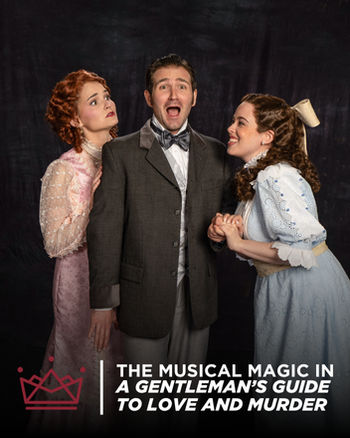
By Liz Armstrong, guest writer
Musicals have long been part of what patrons love to see at the Utah Shakespeare Festival. Hearing our patron’s requests, and after not producing one last season for various reason, the Festival is thrilled to share the magic of the musical, A Gentleman’s Guide to Love and Murder, this season.
Additionally, the Festival is doing something it rarely does. Music Director Brad Carroll plays the piano live on stage, bringing the feeling and spirit of British Music Hall––an equivalent to American Vaudeville––to the Randall L. Jones Theatre. Carroll will conduct the actors, as needed, while also playing the live music alongside pre-recorded tracks, sound effects, and comedic interludes.
“Instead of standing in the booth in the back and triggering all the cues with my index finger [on a computer], I’ll be sitting at the piano cueing them with my left foot,” Carroll said. “I say, ‘Why not?’”
Regarding the decision for the fresh take on the show, Director Amanda Berg Wilson said she “was inspired by opportunities where we can invite the audience into the space with us.” She and Carroll, along with Festival technical and props artisans, built an interconnected piano, computer, and sound system.
The Festival talked with Carroll about the show and creating this fresh take of live music onstage.
Festival: Have you worked on A Gentleman’s Guide to Love and Murder before?
Carroll: It’s a fairly new play; it’s only about ten years old. We haven’t done it at the Festival, but I directed a production in 2018 at Pacific Conservatory Theatre [in California]. So I’m very familiar with the play, but it’s fun to be now just focusing on the music.
Festival: Why are you excited for this show?
Carroll: Amanda’s whole conceit for the play is so much fun. It’ll be really theatrical, which just opens up a whole new world for the play. Gentleman’s Guide is clever, smart, and hilarious. It’s so infected with the British sense of humor, which I really love.
Festival: Why should our patrons come see the show?
Caroll: It’s fresh and new. It’s based on an old movie, and a book before that, that most people don’t know. It’ll be a constant series of surprises for our audiences––it’s so engaging and there’s so much to love about it.
Festival: How do you feel about having a more active role [onstage] this season?
Caroll: I’m going to be doing a lot more than playing the piano. But I have a history of that; my first professional job was at a Vaudeville house. So I go way back doing this kind of wacky stuff. I love this whole idea.
Festival: How are you going to tackle it?
Caroll: The more I work on creating these tracks . . . it’s a lot for two hands and two feet and two ears to take on. There’s so much to juggle. We’re using a lot of technology. The piano that I’ll be sitting at is like a control center. There’s a computer in it; there’s an electronic keyboard; there’s a foot pedal for me to cue all the sound cues as they come. As the sound cue starts playing, I will be playing along with it. The technology has been around for awhile, we’ve just never used it this way [at the Festival].
Festival: What would you say to our patrons who are thinking about attending the show?
Caroll: This is going to be such a romp. It’s a musical, but it’s also a hilarious comedy, sort of like Clue. One actor plays nine different people, and you get to see some of the transitions. We are letting the audience in on those theatrical notions. If people like the magic of theatre, they’re going to get to see it in Gentleman’s Guide.
Festival: What should patrons expect regarding the content of the play?
Caroll: I think people see the word “murder” and get nervous, but there’s nothing to be nervous about. It’s going to be absolute fun. And the music is comical and beautiful and so accessible . . . it’s like British Broadway.
The Festival invites patrons to join in on this theatrical escapade, as A Gentleman’s Guide to Love and Murder is the perfect blend of humor, music, and fun, making it the ideal play for both first-time and experienced theatregoers.
For a quick synopsis of the play and content advisory, click here. A Gentleman’s Guide to Love and Murder previewed on June 19 and closes October 3. Tickets are available to purchase at 800-PLAYTIX or online.
Rosalind: Bold and Brilliant in Breeches
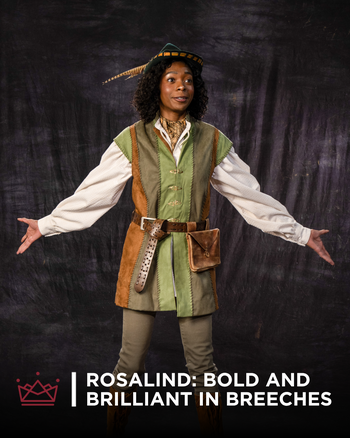
By Kathryn Neves, guest writer
Any Shakespeare buff can tell you, the Bard loved writing powerful women. His plays are packed with powerful heroines, from The Merchant of Venice’s Portia to Titus Andronicus’s Tamora. But of all Shakespeare’s female characters, none of them quite hold a candle to Rosalind. The intrepid star of As You Like It, Rosalind is maybe the most empowered woman in Shakespeare’s canon.
As You Like It is brimming with sparkling wit—thanks, in no small part, to Rosalind. She is quick with a comeback, has a knack for clever turns of phrase, and freely gives out monologues with an intelligence far above the other characters in the play. The only other person who can sometimes match her wit is Touchstone the fool—and Shakespeare fans know that his fools are usually the smartest characters on the stage. Rosalind, though, steals every scene she’s in.
It isn’t just the content of her dialogue that sets her apart. Even outside the text of the play, we can get a good idea of Rosalind’s importance, simply by counting her lines! Rosalind has a whopping 685 lines—more than any female character in Shakespeare’s entire canon. Not only that, but Rosalind has the most lines in As You Like It—giving her the honor of being the only Shakespearean woman to have the leading number of lines in her given play. In fact, she has more than double the lines of her runner-up, Orlando!
As You Like It is one of Shakespeare’s most beloved comedies—and, like the other plays in the genre, it involves a lot of cross-dressing. Rosalind (like Viola and Portia and Imogen) spends a good chunk of the play dressed as a man. In order to protect herself and her cousin, she disguises herself as a man named Ganymede—“Jove’s own page”—and, while dressed this way, gets caught up in a messy love plot with a few forest dwellers. While dressed as Ganymede, she encounters Orlando: the man she loves. She teaches Orlando how to woo her, pretending to be Rosalind—meaning, she is a woman, dressed as a man, pretending to be a woman! (And, to add to the shenanigans, Rosalind would have been played by a man in Shakespeare’s day.)
But Rosalind’s defiance of gender roles goes beyond her masculine disguise. Throughout the play, Rosalind refuses to play by the rules. Women were expected to be passive, docile, and sweet; they were usually seen as weak and helpless, and most often at the mercy of the men in their lives. Rosalind, though, takes action. She provides for and protects herself and her family. She actively pursues Orlando, rather than waiting to be wooed. And she takes charge, giving commands and arranging matches and advising those around her. Rosalind refuses to be confined by the traditional gender roles her society so strictly enforced.
Because of her reputation as one of Shakespeare’s best heroines, many of the world’s greatest actresses have lined up to play her. From Vanessa Redgrave and Helen Mirren, to Patti Lupone and Bryce Dallas Howard—to past Festival productions starring Cassandra Bissell, Melinda Parrett, and Suzanne Cryer—Rosalind is a highly coveted role. And for good reason! You’ll see for yourself just how captivating she is, this summer at the Utah Shakespeare Festival. Directed by Beth Lopes and starring Kayland Jordan as Rosalind, it’s a production that’ll have you saying “Oh wonderful, wonderful, and most wonderful!”
Get your tickets today at bard.org or by calling 800-PLAYTIX.


